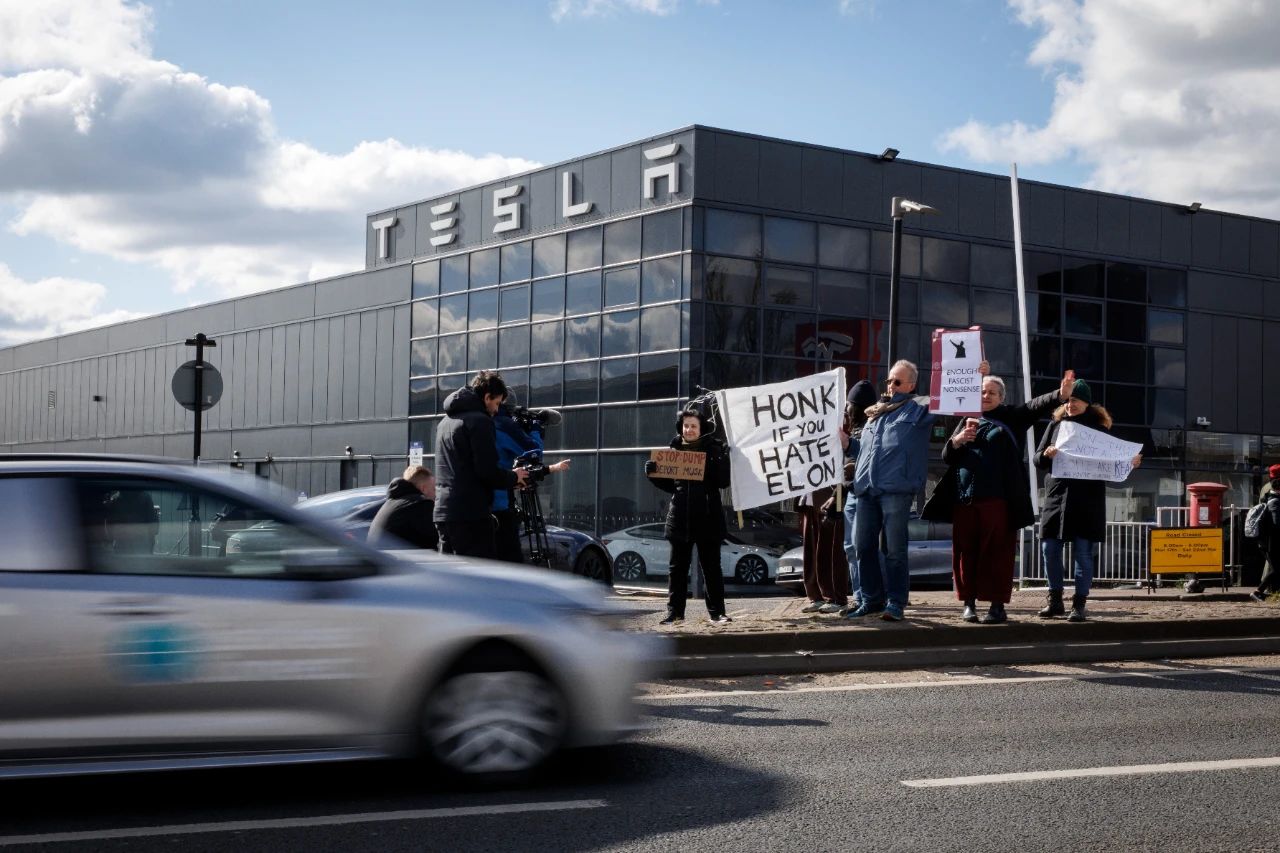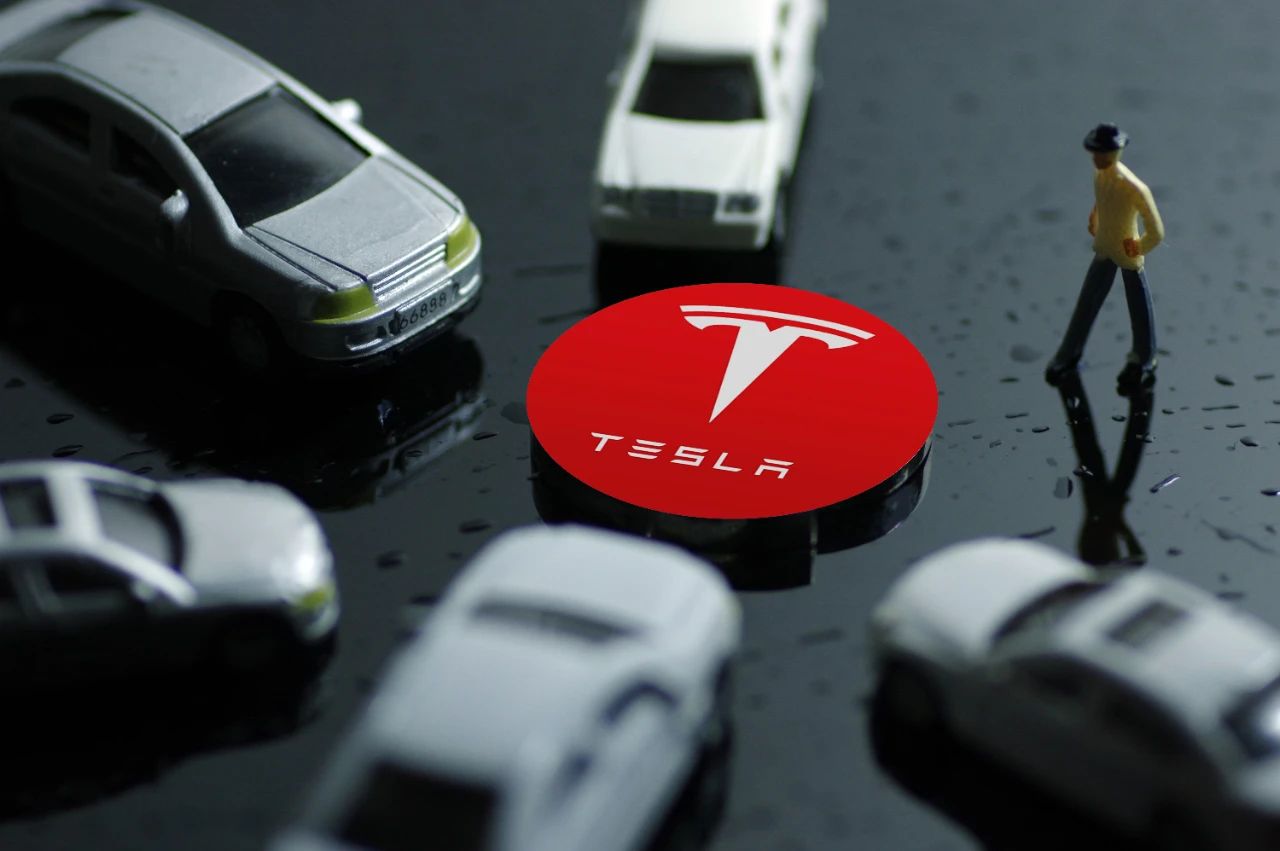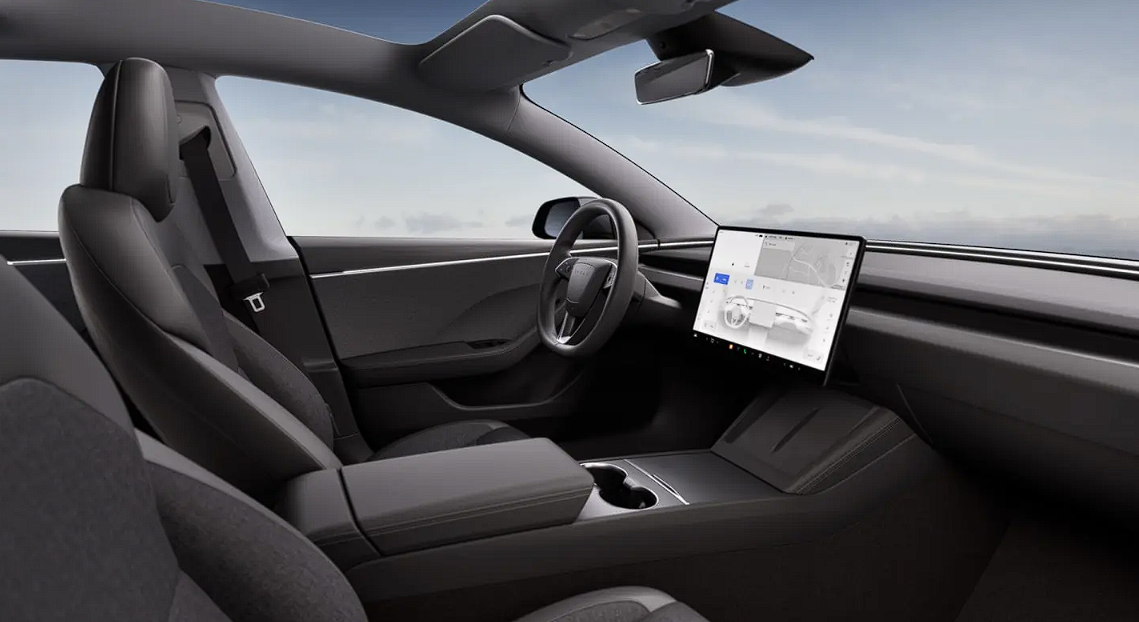Tesla's Troubles Go Beyond Musk
![]() 03/31 2025
03/31 2025
![]() 502
502

Gone are the glory days.
Article | Huashang Taolue Qi Ce
Not only did JPMorgan Chase set a highly damaging and insulting price target for Tesla, but it also directly wrote in its research report: It is difficult to find a similar case in automotive history where a brand has depreciated as rapidly as Tesla.
[Slowing Down]
Since the beginning of this year, Tesla's stock has fallen by more than 30%, making it the worst-performing company among the seven tech giants in the U.S. stock market.
Outsiders often attribute the core reason for Tesla's sharp decline to Musk's involvement in politics, with some even demanding that Musk either resign from his position in the Trump administration or leave Tesla.
Since taking on the role of head of the Trump administration's efficiency department, Musk's public image has deteriorated, and Tesla has become a target of criticism. Protests against Tesla and Musk have intensified across various regions, leading to a "Waterloo" in its global sales.
According to data from AutoCar citing Dataforce:
In the first two months of this year, Tesla sold only 25,852 electric vehicles in Europe, a significant decrease of 45% compared to the previous year.
Even in its U.S. stronghold, Tesla is experiencing consistent negative growth. Data from MarkLines shows that Tesla's new car sales in the U.S. in February decreased by 5% year-on-year, marking the fourth consecutive month of decline.
However, Musk's high-profile involvement in politics does not fully account for the sharp drop in Tesla's stock price. In other words, even without Musk's issues, Tesla's declining performance has already become an inevitable trend.
Despite Musk's efforts in recent years to position Tesla as an artificial intelligence company, offering investors visions of robotaxis, AI, and humanoid robots, the performance of the automotive business remains the most crucial factor affecting shareholders' confidence.
In fact, Tesla's sales had already started to decline before Musk's involvement in politics.
According to official Tesla data, its total vehicle deliveries in 2024 were approximately 1.79 million, a slight decrease of 1% compared to the previous year. This was also the first time since 2015 that Tesla's deliveries had declined year-on-year. During the same period, deliveries from its Shanghai Gigafactory decreased by 3% to 916,700 vehicles, also marking the first decline in deliveries since the factory commenced operations.
Although the declines in both sets of data are not significant, they have already sent a negative signal for Tesla.
Focusing on the Chinese market, Tesla sold 657,000 vehicles in 2024, an increase of 8.8% year-on-year. However, according to Tesla's 2024 financial report, its revenue in the Chinese market was $20.94 billion, a decrease of 3.7% year-on-year. This indicates that:
Tesla's sales growth in the Chinese market came at the expense of price reductions.
More severely, even though it achieved positive sales growth in the Chinese market by sacrificing price for volume, its growth rate significantly lagged behind the industry average. Data from the China Association of Automobile Manufacturers shows that in 2024, sales of new energy vehicles in China reached 12.866 million, an increase of 35.5% year-on-year. Among them, sales of pure electric vehicles increased by 22.6% year-on-year, making Tesla's 8.8% growth pale in comparison.
Correspondingly, Tesla's market share in China's passenger vehicle market is also being further diluted. In 2024, Tesla's market share fell from 8.3% in 2023 to 6.1% in 2024, while BYD's market share increased from 11.5% to 15.4% during the same period.
Tesla's profitability in the automotive business is also declining, with its gross margin falling for three consecutive years, from 29.3% in 2021 to 18.4% in 2024.
Looking at BYD, a new energy vehicle company with a revenue scale similar to Tesla, BYD's automotive business segment generated revenue of 617.38 billion yuan in 2024, an increase of 27.7% year-on-year. Despite also experiencing a year-on-year decrease in revenue per vehicle in 2024, BYD's automotive business maintained a healthy gross margin of over 20%.
Whether comparing horizontally or vertically, Tesla's leading position in the global new energy vehicle market has been significantly eroded.
[Defense and Offense]
The most important reason for Tesla's sluggish growth in car sales is that it has not brought any surprises for too long.
Currently, Tesla only has five models on sale, in the order of their launch: Model S, Model X, Model 3, Model Y, and Cybertruck. The true mainstays are only the Model 3 and Model Y, which account for more than 90% of Tesla's new car sales throughout the year.
The Model 3 was Tesla's first product to reach the mass market. When it was launched in 2016, during the early stages of the development of new energy vehicles, China's new carmaking forces were still struggling to find financing, and their first mass-produced products had just been rolled out.
With its clear positioning as a sports sedan, its market-leading AutoPilot intelligent driving assistance system, and its affordable starting price of $35,000, the Model 3 quickly swept the mid-size car market. Just one week after its launch, it received 325,000 orders, becoming the world's best-selling pure electric vehicle.
It was also in 2020, when the Model 3 began domestic deliveries and the Model Y was put into production, that Tesla's market capitalization surpassed Toyota's, becoming the world's most valuable automaker for the first time.
Counting from its launch, the Model 3 has been on the market for nine years, and the Model Y has been in service for six years.
In September 2023, the Model 3 underwent a major facelift. After the facelift, the exterior changes were not significant, but its iconic sporty attributes were weakened. The cabin was enhanced with features such as ventilated front seats, additional speakers, and a rear entertainment screen. Almost all changes pointed towards luxury and comfort, and even its promotional slogan emphasized being a "mobile home," which has always been the slogan of NIO.
Clearly, Tesla aims to target the household market, which Chinese automakers excel at, even at the expense of performance compromises. However, such a facelift also caused Tesla to lose its "soul," making its driving experience indistinguishable from other brands of electric vehicles.
On the other hand, the Model 3 faces increasing competition from rivals such as XPeng, BYD, NIO, and ZEEKR, all of which are targeting the same market segment as the Model 3. Last year, it also welcomed a stronger competitor in the Chinese market, the Xiaomi SU7. From December 2024 to February this year, Xiaomi SU7 sales have surpassed those of the Model 3 for three consecutive months.
The Model 3's glory days are over, and the Model Y is also facing increasing pressure from Chinese competitors. Within seven minutes of the launch of the 2025 XPeng G6, it received over 5,000 large orders. The AITO Askey R7 has received over 80,000 large orders in just over five months since its launch. Upcoming models such as the XPeng G7, Xiaomi YU7, and LIXIANG i7, which are all competitors to the Model Y, will also be launched within the year.

Under siege, Tesla has experienced strong turbulence in the Chinese market.
According to data from the China Passenger Car Association, Tesla's wholesale sales in February this year were only 30,688 units, a year-on-year decrease of 49% and a month-on-month decrease of 51%, both "halving" and marking the worst performance since July 2022.
Admittedly, this is partly due to the fact that the facelifted Model Y only began domestic deliveries on February 26, and it will take a few months for sales to reflect this. However, the sharp drop in sales immediately after the Model Y's facelift also indicates Tesla's heavy reliance on the Model Y.
To regain the market share lost in China, Tesla plans to take the initiative to attack. According to media reports, Tesla plans to produce a "low-cost Model Y" at its Shanghai Gigafactory. This vehicle, with the internal code name "E41," is developed using Tesla's internal depop approach, which involves rapid product development through simplified configurations while keeping the main functions unchanged.
The "E41" is smaller than the facelifted Model Y and has a 20% lower cost. It is expected to go into production in 2026. According to sources, the "E41" will be mainly sold in the Chinese market. With reference to the starting price of the facelifted Model Y at 263,500 yuan, the "E41" is expected to be priced in the 200,000 yuan range. The vehicle will also be produced in Europe and North America, but the specific timing is unclear.
As early as August last year, Tesla introduced a similar budget version of the Model 3 for the Mexican market: fabric seats replaced leather seats, multi-color ambient lighting became single-color, the number of speakers was reduced from 17 to 9, and seat heating and ventilation functions were removed. For reference, the "E41" will likely also have reduced interior specifications.

It should be noted that Tesla's interior has been criticized for being "barebones." In the context of Chinese manufacturers offering configurations such as refrigerators, televisions, large sofas, and large screens, Tesla's strategy of reducing specifications and lowering prices could be an extremely risky move.
[FSD Is Just So-So]
In addition to new models, Tesla also has high hopes for its FSD (Full Self-Driving) "intelligent driving assistance feature."
In Musk's plan, FSD can not only bring incremental sales to Tesla's new cars but also achieve large-scale commercialization. In other words, in addition to using FSD to enhance competitiveness and promote the sales of Tesla vehicles, FSD itself can also generate significant revenue.
FSD offers two payment models in the U.S. market: a one-time purchase and a subscription. After a price reduction last year, the current optional price for FSD in the U.S. market is $8,000, and the subscription price is $99 per month. Tesla models equipped with HW3.0 produced after 2021 can purchase FSD services.
However, according to Tesla's financial reports, in 2021, FSD revenue was $370 million, accounting for 0.8% of total vehicle sales revenue. In 2024, FSD revenue was $596 million, still only accounting for 0.8% of total vehicle sales revenue.
Faced with the low subscription rate of FSD, some Tesla investors have raised questions, arguing that for a system that requires constant takeovers, even at a reduced price of $8,000, it is still too expensive, and the value of FSD is not clear to most people.
FSD faces a similar situation in the Chinese market.
On February 25, 2024, Tesla overcame data security resistance and announced the launch of the Autopilot automatic driving assistance function for urban roads, marking the official entry of FSD into the Chinese market.
After FSD entered China, there was a wave of trial enthusiasm among domestic users. After trying it out, car owners and bloggers generally evaluated that FSD performed decisively, and the overall driving experience was very smooth. However, in some scenarios, it could also be felt that it reflects North American driving habits, such as not slowing down at green lights, encroaching on bus lanes, and crossing solid lines, often leading to violations.
Therefore, some people have summarized that the current FSD in China is like hiring an experienced driver from California.
The various issues of "incompatibility" exhibited by FSD mainly stem from Tesla's lack of local data. Tesla has deployed an AI training supercluster named "Cortex" within its Austin Gigafactory, which brings together 100,000 NVIDIA H100 and H200 chips dedicated to training FSD and the Optimus humanoid robot.
However, currently, despite the powerful computing power of "Cortex," due to the lack of real vehicle data from China, it can only use publicly available videos of Chinese roads on the internet for training. Naturally, its effectiveness cannot compare to the real vehicle data of domestic manufacturers.
At the same time, China's traffic rules are very complex. Musk once gave an example: "On bus lanes, sometimes private cars are allowed to enter during the day, but sometimes they are not. If you accidentally drive into a bus lane at the wrong time, you will immediately receive a ticket." This greatly affects Tesla's local adaptability.
To solve the training problem, there are reports that Tesla may lease or establish a computing center in China. The industry generally believes that FSD has strong technical capabilities, and if the data source and training issues are resolved, it will improve rapidly.
However, the current trend in China's intelligent driving market is as He Xiaopeng described: "Standard hardware, free software, frequent OTA updates." Moreover, competition is also becoming increasingly fierce.
For example, the newly launched 2025 XPeng G6 and G9 come standard with Turing AI driving assistance, without the need for optional purchases, subscriptions, or fees. In contrast, the subscription price for FSD in China is 64,000 yuan, and only a one-time purchase option is provided, which is completely contrary to the market environment of Chinese users. This huge sense of "sacrifice" makes it difficult for users to make a decision.
"If FSD wants to be competitive in the domestic market, its price must be in line with local market conditions; otherwise, consumers will definitely vote with their feet," said a Tesla owner to us.
In addition to the slow development of its own models, the many practical problems faced by FSD, and the fierce competition from China's new energy vehicle industry, Tesla now also has to face another equally formidable challenge: the electric counterattack from global traditional automakers.
According to estimates from Cox Automotive, Tesla's market share in the U.S. fell from 55% in 2023 to about 49% in 2024. During the same period, traditional automakers such as General Motors, Ford, Hyundai, Honda, and Toyota all experienced significant growth in pure electric vehicle sales in the U.S.
In the European market, Tesla is also facing encroachment from German cars, showing a reciprocal relationship. In the first two months of this year, Volkswagen's electric vehicle sales in the European market increased by 182%, in sharp contrast to Tesla's 45% decline.
Looking further ahead, Musk's visions of robots and AI may also fail to dominate as he has described. For example, in the field of humanoid robots, which Musk believes to be the biggest business opportunity, Chinese competitors seem to be moving faster than Tesla.
In the past, the capital market was willing to believe in the business fantasies proposed by Musk and gave Tesla a super-high premium. However, now that fantasies are being tested by reality, the capital market is re-evaluating Tesla. From Wall Street's perspective, Tesla's market value bubble has not yet been fully squeezed out. UBS has downgraded its target share price to $225, while JPMorgan Chase has even more drastically downgraded it to $120.
Not only did JPMorgan Chase set a highly damaging and insulting price target for Tesla, but it also directly wrote in its research report: It is difficult to find a similar case in automotive history where a brand has depreciated as rapidly as Tesla.
【Reference Materials】
[1] "Tesla Aims to Reduce Model Y Production Costs by Over 20% to Defend Market Share in China", Gasgoo Auto Community
[2] "Tesla's Mexico Model 3 Rear-Wheel Drive Entry Model Interior Downgrade: Cancellation of Seat Heating/Ventilation, Removal of Rear Small Screen, Sold for 749,000 Pesos", IT Home
[3] "Responding to China's Price War, Tesla Also Plans a Low-Cost 'Model Y'|36Kr Exclusive", 36Kr Auto
[4] "Exclusive 丨 Tesla China Promotes FSD Launch, Headquarters Team Parachutes in to Assist Optimization" LatePost Auto
[5] "Tesla's New Model 3's Risky Positioning: From 'Road Racing Car' to 'Mobile Home'|Auto Gallery" 36Kr Auto
[6] "Tesla's FSD Entry into China is Imminent, but No One in the US is Buying It" Auto Business Review
——END——
Welcome to follow 【Huateaolue】, recognize influential figures, read strategies and legends.
All rights reserved, no unauthorized reprinting allowed
Some images are sourced from the internet
If infringement is involved, please contact us for deletion







